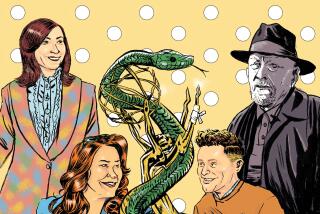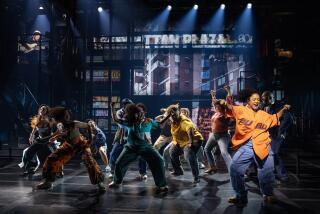‘First 10 Awards’ Isn’t Just a Warmup for the Tonys Show
NEW YORK — There is something awe-inspiring about watching the pros work--in this case, the cast of Broadway’s “Kiss Me, Kate,” which is tweaking one of its signature numbers, to Cole Porter’s “Too Darn Hot,” for an appearance on “Late Night With David Letterman.”
Choreographer Kathleen Marshall is telling them to bring it down a bit, not to “dance it through,” but when they go through the routine full-speed, it looks as if someone is liable to break something--a leg, a hip, a back, a neck. They raise a fundamental question: Does the body actually bend that way?
Capturing these exhilarating contortions is the camera crew of “The First 10 Awards: Tonys 2000,” which will use the footage to illustrate what a choreographer does. “The First 10 Awards”--which covers best direction of a play and musical, choreography, original score, book of a musical, orchestration, costume design, scenic design and lighting (there’s also a regional theater award)--airs on PBS on Sunday during the first hour of the Tonys starting at 8 p.m. (the production is broadcast live on the East Coast but tape-delayed for the West Coast), then CBS takes over with the rest of the awards for the final two hours.
Do not, under any circumstances, suggest to producers Jeff Folmsbee and Mark Mannucci that the PBS show is some sort of warmup to the CBS production. Folmsbee, a high-energy type who rides a bicycle around town, goes ballistic at the idea, explaining testily that plays and musicals are uniquely collaborative, that, in effect, the players celebrated on CBS (best actor, actress, etc.) are no more important than the people who clothe them, light them, direct their movements, put words in their mouths.
“What Jeff is saying is that there is this four-year bias against this show,” says Mannucci, a bit more mild-mannered, over a beer in a theater district watering hole. He’s referring to the fact that the show, in its fourth year, has previously been called “Broadway ’97 (‘98, ‘99): Launching the Tonys.” Before PBS stepped in, at the behest of the League of American Theatres and Producers and the American Theatre Wing, the awards were announced prior to the broadcast.
“That name has created the perception that it’s a pregame show,” Mannucci continues. “I’m sure in prior years, with the title being ‘Launching,’ people said, ‘Oh, I’ll watch the Tony Awards, but I don’t want to watch the “What are you wearing tonight?” show that they do on the Oscars.’ We’re not a pregame show, we’re the first 10 awards, hence the title this year.”
*
This thinking even infected some of the participants. This year, the directors and writers lobbied to be moved from PBS to CBS, but according to Folmsbee and Mannucci, good sense prevailed. They realized that though there won’t be the same number of viewers watching them win (or lose) on “The First 10 Awards,” they’ll have much more exposure, because the PBS hour features in-depth looks at what they do in addition to the traditional award giving. CBS, on the other hand, features award giving, host Rosie O’Donnell and production numbers, which are long on entertainment and short on context.
It has to be said that context is not as dully educational, as oppressively good for you, as it might seem. It gives the TV audience a rooting interest in the lesser-known nominees and helps animate the dramas, which no matter how compelling live always look stagy and flat on a TV screen.
*
These contextual “packages,” as Mannucci calls them, are anywhere from four to 10 minutes, which the Tony audience at Radio City Music Hall watches along with TV viewers. Usually there are three of them, the first, running at the beginning of the show, featuring the musicals, much of it a montage of actual performances caught with cameras held by Mannucci and other cameramen sitting with a paying audience (Equity allows them half an hour to shoot the footage).
This is followed by award giving (choreography, orchestrations, book, score) and then a piece about the designers. They in turn are awarded and then the final package, about the directors, is broadcast, after which their Tonys are given. Folmsbee, who helped create the format, says this year will be much the same, though some of the elements will be broken up.
According to Mannucci, each package is prepared at three lengths because the winners sometimes become, as he puts it, “loquacious” and run long. In fact, the science of calibrating loquaciousness is so fine that they may run a shorter package in anticipation of a front-runner notorious for being loquacious receiving an award. Assisting them is a back timing computer in the CBS producing truck that calculates how much time they have, starting at 56 minutes, 56 seconds.
“It’s very complicated,” Mannucci says dryly.
And that’s not the half of it. The producers have to see all the shows, some two dozen in all, and then figure out which ones are likely to be nominated. Then they go about the business of interviewing 25 to 30 potential nominees, shooting their sets and rehearsals, filming their performances. This all happens in the eight weeks before the announcements, this year on May 8. Whatever they missed has to be filled in--crammed in, really--between May 8 and the ceremonies. Mannucci illustrates how he feels on announcement day by holding out his hand--it’s shaking.
Reached after the nominations were announced, Folmsbee says, “We handicapped things pretty well. We didn’t waste a lot of effort. A lot of the things we shot were nominated.”
Folmsbee, who coordinates the PBS program, including negotiating with a half-dozen or so unions and a gaggle of press agents, also selects the presenters for the show, in conjunction with CBS. He says he’s interested in presenters with roots in theater rather than the movies. (Last year, for example, they had playwright David Hare, director Julie Taymor, and actors Judi Dench, Alan Cumming and Audra McDonald.)
One of the things the Tonys has always had going for it is that the presenters are accustomed to being in front of a live audience and look at ease, whereas the film actors on the Oscars are often wooden and sometimes seem even downright put-upon. However, there will be at least one show-biz personality on PBS’ Tony show.
“Rosie O’Donnell will be hosting our show live,” Folmsbee says. Nathan Lane has since signed on to lend her a hand as co-host of the PBS show. “Of course, last year Rosie didn’t do anything with the Tonys, but the previous two years she did a pretape for us in which she said, ‘Hey, I’m Rosie, watch this show.’ This year, being consistent with the idea that this is a three-hour ceremony, that it’s one big event covered by two networks, Rosie will open the ceremony live on our show and at the end of the hour throw to CBS and then do the CBS thing.”
So the show has undergone a title face-lift and received the Rosie imprimatur. Perhaps these changes will help attract viewers. And then, in the words of “Kiss Me, Kate” choreographer Marshall and the images of her furiously sweating dancers flying across the stage, Broadway will speak for itself.
* “The First 10 Awards: Tonys 2000” can be seen Sunday at 8 p.m. on KCET-TV.
More to Read
The complete guide to home viewing
Get Screen Gab for everything about the TV shows and streaming movies everyone’s talking about.
You may occasionally receive promotional content from the Los Angeles Times.






